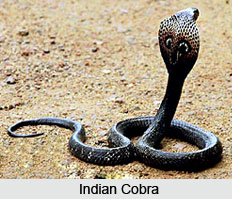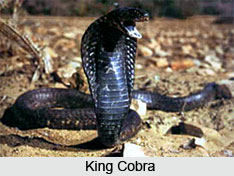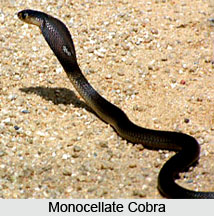 India Cobra is a harmful snake and is one of the "big four", species inflicting the most snakebite in India. The species name of the Indian Cobra is naja. It has a small `cuneate` scale between the 4th and 5th infralabials and there is a peculiar touching the intranasal, and also there is the presence of a 3rd supraliminal in contact with the eye.
India Cobra is a harmful snake and is one of the "big four", species inflicting the most snakebite in India. The species name of the Indian Cobra is naja. It has a small `cuneate` scale between the 4th and 5th infralabials and there is a peculiar touching the intranasal, and also there is the presence of a 3rd supraliminal in contact with the eye.
Description of Indian Cobra
The elongated ribs of the 3rd and 27th vertebrae form the hood of the Indian cobra. The 9th rib on the left and 10th rib on the right are the longest, the preceding and succeeding ribs are shortened. The head of the cobras are depressed with a short and round snout. Its nostrils are large and pupils are round. There is a swelling at the temporal region over the underlying poison glands. There are distinct grooves on its spine. The cobras are variable in coloration and markings. Three races of cobras are recognized on the basis of the hood pattern. One is the `spectacled` or bioccelate cobra of peninsular India (Naja naja naja), which is yellowish, brownish or black above with or without a black and white mark on hood, a black and white spoon the inside of the hood with one or two black crossbars below hood.
Monocellate Cobra (Naja naja kaouthia) differs from the other cobras in having a single yellow or orange O-shaped mark on the hood. They are olive brown or black in colour. This is the common Cobra found in eastern India and eastwards of India. The Black Cobra (Naja naja oxiana) occurs in the extreme northwest. In the younger stages they are light grey or brown and have dark crossbars. Adults are brown or black.
Life Cycle of India Cobra
Indian Cobra is a native to the Indian sub-continent. The cobras are eclectic in habitat. They are found almost anywhere, in heavy jungle, open cultivated land, populated areas etc. They are often found near or in water. It is often timid but aggressive when disturbed. The young ones are more dangerous than the adults.
The cobra feeds on rats, frogs, toads, birds, lizards and other snakes including other cobras. It also eats eggs. Eggs are swallowed as a whole and digested in about 48 hours.

There are two fully operative canaliculate fangs on each side. These are shed singly at intervals. The fangs are about 7 mm in length. The poison glands are similar to the parotid salivary glands in mammals and have the shape and size of an almond kernel.
Indian cobras are oviparous and lay their eggs between the months of April and July.
Venom of Indian Cobra
The venom is a clear, viscid fluid resembling olive oil in appearance. The amount of venom secreted varies with age, vitality and temper of the animal. The poison acts mainly as a neurotoxin and blood and cell destroyer. The neurotoxin paralyses the respiratory centre and is the chief cause of death. Other deadly effects of the venom are loss of clotting power of the blood and destruction of red blood cells.
The symptoms are a stinging or burning plan accompanied by swelling and oozing of bloodstained serum. The effects are gradual but rapidly advancing paralysis commences with the legs, the neck droops, the muscles of the tongue, lips, and throat, are affected and speech becomes difficult. The lower lip falls and allows saliva to dribble, swallowing becomes difficult or impossible. Breathing becomes difficult, laborious and stops. Other symptoms are vomiting and haemorrhage from the various orifices of the body.
The bite of a cobra is not fatal at all times. Fatality depends on the quantity of venom injected, the natural resistance of the victim, the condition of the snake and various other factors.

King Cobra is another species of Indian Cobra which is the third largest snake in India.
Its body is robust and the scales are glossy. The `hood` is dilatable than in the cobra. Its head is flat and snout is round. Its pupil is round. It has occipital shields on its body.
It is a highly dangerous snake. It has an excellent eyes sight, outstanding intelligence and sensitivity to vibrations compared to other cobra species. It swallows the prey as a whole and its toxins begin the digestion of the victim. It does not have rigidly fixed jaws but has extremely pliable ligaments, enabling the lower jawbones to move independently of each other. After a large meal the snake may live for many months without another meal due to a very slow metabolic rate. King Cobras are able to hunt at all times of day, although it is rarely seen at night, leading some to erroneously classify it as a diurnal species.
Mythology related to Indian Cobra
There are numerous myths related to Indian Cobras. According to Hindu mythology Indian Cobras are worshipped as a powerful deity. Lord Shiva is often depicted with a protective cobra coiled around his neck. Lord Vishnu, the preserver of the universe, is usually portrayed as reclining on the coiled body of Sheshnag, the Pre-eminent Serpent, a giant snake deity with multiple cobra heads. Cobras are also worshipped during the Hindu festival of Nag Panchami Vrata.











